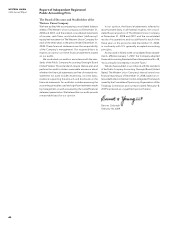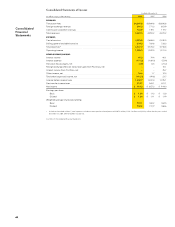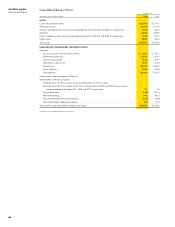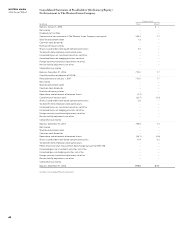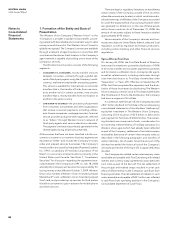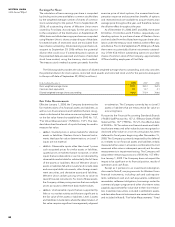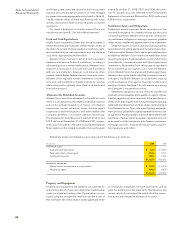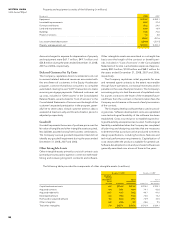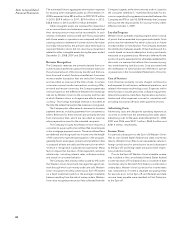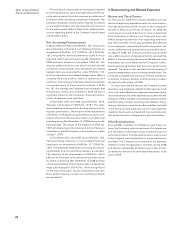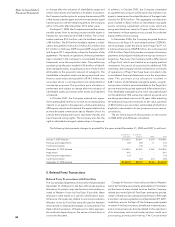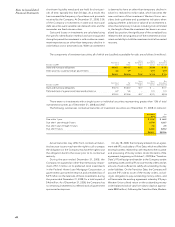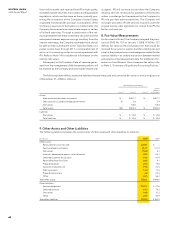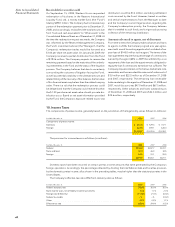Western Union 2008 Annual Report Download - page 55
Download and view the complete annual report
Please find page 55 of the 2008 Western Union annual report below. You can navigate through the pages in the report by either clicking on the pages listed below, or by using the keyword search tool below to find specific information within the annual report.
5353
Notes to Consolidated
Financial Statements
and floating rate notes are carried at their discounted
notional amounts, except for portions of notes hedged
by interest rate swap agreements as disclosed in Note 14.
The fair market values of fixed and floating rate notes
are also disclosed in Note 15 and are based on market
quotations.
For more information on the fair value of financial
instruments see Note 8, “Fair Value Measurements.”
Cash and Cash Equivalents
Highly liquid investments (other than those included in
settlement assets) with maturities of three months or less at
the date of purchase (that are readily convertible to cash),
are considered to be cash equivalents and are stated at
cost, which approximates market value.
Western Union maintains cash and cash equivalent
balances with various financial institutions, including a
substantial portion in money market funds. Western Union
limits the concentration of its cash and cash equivalents
with any one institution; however, such balances often
exceed United States federal deposit insurance limits.
Western Union regularly reviews investment concentra-
tions and credit worthiness of these institutions, and has
relationships with a globally diversified list of banks and
financial institutions.
Allowance for Doubtful Accounts
Western Union records an allowance for doubtful accounts
when it is probable that the related receivable balance
will not be collected based on its history of collection
experience, known collection issues, such as agent
suspensions and bankruptcies, and other matters the
Company identifies in its routine collection monitoring.
The allowance for doubtful accounts was $21.6 million and
$13.8 million at December 31, 2008 and 2007, respec-
tively, and is recorded in the same Consolidated Balance
Sheet caption as the related receivable. During the years
ended December 31, 2008, 2007 and 2006, the provi-
sion for doubtful accounts reflected in the Consolidated
Statements of Income was $26.6 million, $23.5 million and
$24.4 million, respectively.
Settlement Assets and Obligations
Settlement assets represent funds received or to be
received from agents for unsettled money transfers and
consumer payments. Western Union records correspond-
ing settlement obligations relating to amounts payable
under money transfer and payment service arrangements.
Settlement assets consist of cash and cash equivalents,
receivables from selling agents and investment securities.
Cash received by Western Union agents generally becomes
available to Western Union within one week after initial
receipt by the agent. Cash equivalents consist of short-term
time deposits, commercial paper and other highly liquid
investments. Receivables from selling agents represent
funds collected by such agents, but in transit to Western
Union. Western Union has a large and diverse agent base,
thereby reducing the credit risk of the Company from any
one agent. In addition, Western Union performs ongoing
credit evaluations of its agents’ financial condition and
credit worthiness. See Note 7 for information concerning
the Company’s investment securities.
Settlement obligations consist of money transfer and
payment service payables and payables to agents. Money
transfer payables represent amounts to be paid to trans-
ferees when they request their funds. Most agents typically
settle with transferees first and then obtain reimbursement
from Western Union. Due to the agent funding and settle-
ment process, payables to agents represent amounts due
to agents for money transfers that have been settled with
transferees. Payment service payables represent amounts
to be paid to utility companies, auto finance companies,
mortgage servicers, financial service providers, govern-
ment agencies and others.
Property and Equipment
Property and equipment are stated at cost, except for
acquired assets which are recorded at fair market value
under purchase accounting rules. Depreciation is com-
puted using the straight-line method over the lesser of
the estimated life of the related assets (generally three
to 10 years for equipment, furniture and fixtures, and 30
years for buildings) or the lease term. Maintenance and
repairs, which do not extend the useful life of the respec-
tive assets, are charged to expense as incurred.
Settlement assets and obligations are comprised of the following (in millions):
December 31, 2008 2007
Settlement assets:
Cash and cash equivalents $ 42.3 $ 203.5
Receivables from selling agents 759.6 921.9
Investment securities 405.6 193.8
$1,207.5 $1,319.2
Settlement obligations:
Money transfer and payment service payables $ 799.5 $ 870.8
Payables to agents 408.0 448.4
$1,207.5 $1,319.2



